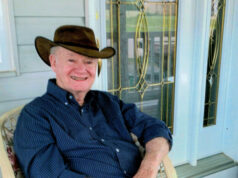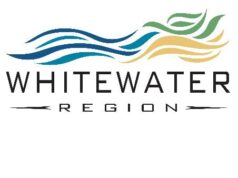By Connie Tabbert
Editor
COBDEN — Whitewater Region Township council is pleased with what the volunteers with the Muskrat Watershed Council have accomplished in less than a year’s time.
“We really wanted to come by and update you on our efforts and thank you for your administrative, moral, public and financial support,” said Rosalie Burton, chair of the council.
The Muskrat Lake Watershed council was formed following a water quality symposium held in the fall of 2013. From that, about 200 concerned citizens wanted to keep informed of the issues on the muskrat watershed, she said.
“That was really a watershed moment for me,” Ms. Burton said. “It was my first introduction to issues that were happening in the watershed and sparked my involvement as well as many people who are on our council and helping us as volunteers.”
There were public consultations in November 2013 and May 2014 and then in August, the annual general meeting was held, she said. The council is comprised of five executives and eight directors, Ms. Burton said. An outreach program has been done reaching a large number of people, groups, organizations, businesses and ministries, she said.
There are five director positions filled, and the most recent voluteers to step forward was Karen and Ranee Coulas, who are the directors of agriculture.
The volunteers continue to work on the science based research with Algonquin College, she said. The Water Adaptation Quality Management Initiative is ongoing, and from that, there will be the first ever real look at scientific data over time –from the spring run-off to fall and freezing of the water, to find where water quality issues are, she added.
The council has partnered with Bishop Technologies and purchased two bio chord islands (rafts). Based on scientific data from the Algonquin College study, it will be able to identify strategic places to put those two rafts to decrease nutrient loading in the watershed. Ms. Burton said the rafts will be installed in the spring.
There has been active media support, and by getting the watershed council out to the public, there have been several organizations who have endorsed the watershed council and invited them to come and speak, she said.
The council has been kept informed of the blue green algae on Muskrat Lake as well as the reasons why the Cobden beach remained closed all summer, she said.
The watershed council remains in communication with the five municipalities involved in the watershed, namely, Pembroke, Laurentian Valley, North-Algona-Wilberforce, Admaston/Bromley and Whitewater Region. They are meeting with the Algonquin First Nations in November (rescheduled from earlier this summer) and have partnered with Algonquin College as they move through a science and research phase. The council is also working with federal and provincial agencies, she added.
Renfrew-Nipissing-Pembroke MPP John Yakabuski’s staff is working with the council to ensure the watershed is marked as a priority area in terms of provincial policy, Ms. Burton said
“We are hoping to be on a level playing field with Bay of Quinte, Simco Lake, Lake Erie, etc.,” she said.
Ms. Burton said the vision and mission statements are not paper based exercises.
“They help us identify our priorities and assign our limited resources,” she said.
The council is getting information out by attending various events, such as the Cobden Fair, Renfrew County Plowing Match,; they made a presentation to the Lake Dore Property Owners Association; is working with the Muskrat Lake Association and has an upcoming meeting with the Mink Lake Association.
It was also agreed more communication was required, not only to reach members, but as many people as possible, she said. A web site was developed, as well as a Facebook page and twitter. Ms. Burton noted the first newsletter was recently sent out.
“We’re making a major effort to get the word out to people and get people actively involved,” Ms. Burton said. “When we do an e-mail mail-out, we reach almost 500 people.”
The watershed is about 500 square kilometres, she said. It’s not just the lake, but rivers, streams, creeks and any other tributaries.
“We all live, work and play in the watershed,” Ms. Burton said. “It’s important that we look at a strategy and funding solutions and long term strategic actions that actually help us address things, from drinking water to recreation to tourism and development. It’s the whole gamut that we’re wanting to influence here and get involved.”
The council sought support from the municipal council for a farmer who was hoping for provincial funding because of his construction of a cement manure pit on his farm which was close to a tributary that goes to Muskrat Lake, she said. The council is waiting to hear if the farmer received provincial funding. If he receives the funding, this project would be used as a best management practice to be used as a demonstration site, Ms. Burton added.
Currently, the watershed council is waiting for a corporation number for non-profit status, she said. It is also seeking charitable status, she added. Members met with directors from the Minister of Environment and Minister of Natural Resources and have identified someone to meet with them to talk about the pros and cons of charitable status. Charitable status is where the big money is, she explained.
“You apply for and receive the large grants that will fund the solutions that we identify going forward,” Ms. Burton said. “We want to be with the Royal Bank of Canada and have their charitable funds. We want the Green Team with TD Bank, etc. Some of the big ones that require charitable status before you can even be considered.”
She said there might be a need for a sidearm of the council to be charitable and the other remain not-for-profit, she said. This way, the watershed council can qualify under two grant systems.
The council has identified 30 sources of funding it can tap into. It’s the capacity of the volunteer group to get the applications in, she said.
Ms. Burton also said ministry staff said if they put together a proposal for an intern, it might happen and it could be three-quarters of a year commitment, she said.
The council is currently looking for best management practices in conjunction with the Algonquin College study now underway and helping them through our science and water quality to prepare for next year’s grant proposals so there is data information and best management practises identified on a two to three year term, Ms. Burton said.
The Muskrat Lake Watershed Council is hosting an event of science based solution and recommendations at the Cobden Ag Hall on Oct. 9.
“We want to have a little bit of a show and tell of what we’ve learned so far,” Ms. Burton said. “In many ways we’re not so unique. There are other places struggling with the same issues and coming up with solutions. We want to leverage those instead of starting from ground zero.”
Ms. Burton said there will most likely be a second night because there is a lot of information to cover.
The council will continue with outreach and communication, as this is a community driven council. The council has also partnered with the Center for Sustainable Watersheds for Shoreline Stewardship and Love Your Lakes program in Perth. Ms. Burton said while the council actively works towards charitable status, it will need funding. Reviewing the $3,500 budget, she said it includes $1,000 to get the charitable status, insurance is about $1,000, attending events costs about $400 as well as postage, nation builder (web site, survey tool, etc.) and project funding.
She questioned if it would be possible for the municipal council to take $1,000 from this year’s budgeted $4,000 and put it in reserve for next year for the watershed council.
The township council agreed to the request.
Councillor Joey Trimm said there are times when municipal council and staff who attend conferences sometimes get meetings with ministers. He suggested the watershed council put together a letter to be used to set up a meeting.
Reeve Don Rathwell said the watershed council is lucky Ms.Burton has taken the leadership role.
“The mess that Muskrat Lake was in and where you have brought us to this point with your committee is wonderful,” he said.
He suggested if a meeting is granted at the provincial level, the County Warden and MPP attend, because he has seen a meeting scheduled for only 10 to15 minutes get extended to 20 to 25 minutes.
“I think we should keep this in mind,” he said. “The more you have sitting around the table, the better.”
Mayor Jim Labow said, “The work your committee has taken on, on a volunteer basis, is very important, because we do not, as a council, have the expertise in cleaning up the lake. We get told we should have, but we don’t and I don’t think any council in Ontario would have that expertise. You are drawing people in and working on it that way and that’s the way it has to be done.”







![Kenopic/Smith Auction [Paid Ad]](https://whitewaternews.ca/wp-content/uploads/2018/10/advertising-100x75.jpeg)

